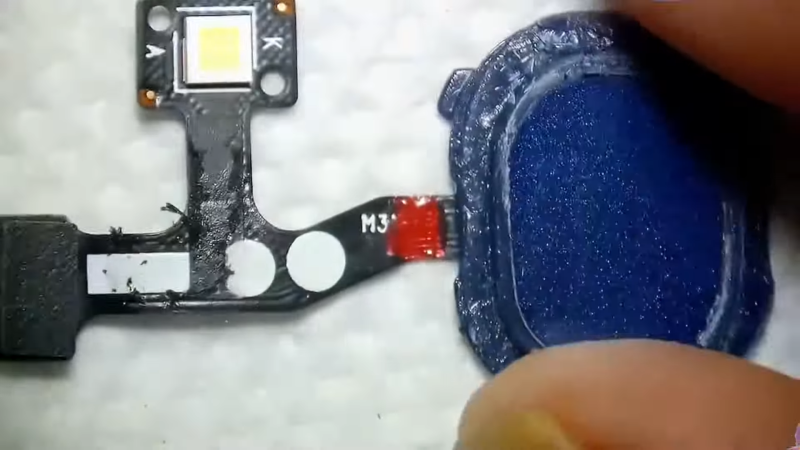Some might consider a broken ribbon cable to be unsalvagable. They’re delicate and fragile as can be, and sometimes just fussing with them further is enough to cause additional damage. However, with the right set of skills, it’s sometimes possible to achieve the unthinkable. As [Master Liu] demonstrates, you can indeed repair a broken ribbon cable, even a tiny one.
 The video concerns a ribbon cable linked to a Touch ID fingerprint sensor from an Apple device. It’s common to break these ribbon cables when repairing a phone, and doing so causes major problems. The Touch ID device is paired with the host phone, and cannot easily be replaced. Thus, repair is justified if at all possible.
The video concerns a ribbon cable linked to a Touch ID fingerprint sensor from an Apple device. It’s common to break these ribbon cables when repairing a phone, and doing so causes major problems. The Touch ID device is paired with the host phone, and cannot easily be replaced. Thus, repair is justified if at all possible.
The repair involves scraping back the outer coating on the two sections of ribbon cable to reveal the copper pads underneath. The copper is then coated with flux and solder to prepare them to be rejoined. Ultra-fine strands of wire are used to join the individual traces. Then, the repaired section is coated in some kind of sealant or epoxy to hold the joint together and protect it from failing again. The theory is easy, it’s just the execution that’s hard.
Ribbon cable repair is becoming one of our favorite topics of late. Sometimes you just need a steady hand and the guts to have a go. Video after the break.
















For those that have the steady hand and patients I commend you. Now as I get older many projects I wont take on, mind you there are many where it is easy to tear a cable in repairs. Or the warning and pop up of a feature loss with iOS unhappy with changes.
Keep up the good work; will always be a place for you and your skills.
Depends upon the ribbon cable. I’ve had it where one can free both ends and replace.
While impressive, it’s a sad state of affairs that the consumer isn’t allowed to swap a like-for-like component on a device they own without the manufacturer giving them real-time explicit permission for every instance of component replacement.
Pass me your phone, and let me drop my security chip into it…
There’s a reason for it here.
You mean you will open the phone, replace four cent component with your malicious one behind your back and return it in 10 seconds? With a phone that has been glued in?
The real reason is controlling the whole ecosystem and maximising service/new device sales revenue. If they want security, they could also sell four cent OEM components with 1000% markup instead of the biggest possible subassemblies as spares.
Easily solved with a client side challenge and response. If you can defeat that, you can defeat Apple’s verification.
It’s a piss weak excuse to unfairly undermine independent repairers, just like breaking the colour calibration on screens. Hell, Apple have used anti counterfeiting legislation to seize and destroy their own components when imported by independent businesses. Stop licking the corporate boot.
(not replying to myself, there’s another Dan).
Yeah what they said (Dan squad is here)
The last ribbon/flat flex repair I did, I ended up having to make a whole new flat flex as the original one was made with conductive ink instead of copper.
It was for the buttons on a Tektronix THS700 series handheld scope, the gold plated on copper traces work brilliantly.
(Click my name above for the video)
Looks really nice, maybe a bit overkill but the original one was probably too far gone. I use conductive graphite or silver paint if one or two traces are bad, in fact I even fixed a few membrane keyboards from laptops and keyboard covers where i couldn’t find a proper replacement. But you always risk other traces being iffy.
Best thing about this? A video that shows you everything you want to see and takes less than 30 seconds to do so. Some people would manage to blow this out to 28 minutes.
But I had to slow it down to properly see the wires being applied and cut.
That’s… not from an Apple device, right?
I bet it’s not even tied to the security chip like actual Apple Touch ID sensors. Nice fix though, even if it might be completely unnecessary lol
From the looks of it, might be a Samsung fingerprint sensor because the flash is on the same ribbon cable.
I remember I fixed a flex from a phone using my laser to precise remove the plastic on the top ,making room for the solder paste, I was like wow it looks so cool! I think i still have the g-code somewere. I went by trying and error adjusting the power lever using a disposable flex ,sadly i didn’t take pics :(